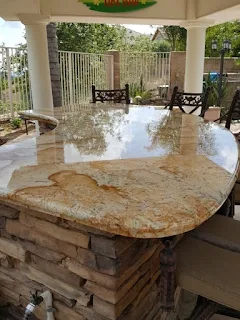Restoring the Beauty of Granite Countertops: A Comprehensive Guide
Granite countertops have long been prized for their durability, elegance, and natural beauty. However, over time, even the most robust materials can succumb to wear and tear. Daily use, exposure to various elements, and the occasional mishap can lead to scratches, stains, and a loss of the granite's luster. Fortunately, with proper care and restoration techniques, you can bring your granite countertops back to their original splendor. In this article, we'll explore the various aspects of granite countertop restoration, from identifying common issues to implementing effective restoration methods.
Identifying Common Issues
Before embarking on a restoration journey, it's essential to identify the issues plaguing your granite countertops. Common problems include:
Scratches: Granite is relatively scratch-resistant, but abrasive materials and sharp objects can leave marks over time.
Stains: Granite is porous, and certain substances like oils, acidic liquids, and colorful foods can lead to unsightly stains.
Dullness: Frequent cleaning with abrasive cleaners or using improper cleaning techniques can strip granite of its natural shine.
Chips and Cracks: Heavy impact or sharp blows can lead to chipping or cracking of the granite surface.
Unevenness: Over time, heavy items placed on countertops can cause slight shifts, resulting in uneven surfaces.
The Restoration Process
Cleaning: Start by cleaning the countertop with a mild, pH-neutral cleanser and warm water. Avoid harsh chemicals that can damage the surface further. Gently scrub away any dirt or grime, and pat it dry.
Removing Stains: To address stains, create a poultice using a mixture of baking soda and water. Apply the poultice to the stained area, cover it with plastic wrap, and let it sit overnight. The poultice will draw out the stain, allowing you to wipe it away gently the next day.
Polishing: Restore the granite's shine by polishing the surface. Use a granite-specific polishing compound or a DIY solution like a mixture of baking soda and water. Apply the polish in circular motions, then wipe it off and buff the countertop to a high shine.
Repairing Chips and Cracks: For minor chips, consider using an epoxy resin specifically designed for granite repair. Clean the area thoroughly, apply the epoxy, and let it cure. For larger chips and cracks, it's recommended to consult a professional.
Sealing: To prevent future stains and maintain the restored look, apply a granite sealer. Choose a high-quality, penetrating sealer that will fill the pores of the stone. Follow the manufacturer's instructions for application and reapplication intervals.
Preventive Maintenance: To extend the life of your restored granite countertops, adopt a few simple preventive measures. Use cutting boards and trivets to avoid direct contact with hot pots and pans. Clean up spills promptly, and avoid using acidic or abrasive cleaners.
When to Seek Professional Help
While many restoration tasks can be accomplished on your own, there are instances where professional assistance is advisable. If you're dealing with extensive damage, such as significant cracks or large chips, it's best to consult with a stone restoration expert. They have the expertise and tools to handle complex repairs effectively.
Conclusion
Granite countertops are an investment that can last a lifetime when properly cared for and maintained. By identifying common issues, following the restoration process, and adopting preventive measures, you can restore the beauty of your granite countertops and enjoy their timeless elegance for years to come. Whether you're dealing with scratches, stains, or dullness, a little effort and attention can breathe new life into your kitchen or bathroom space, allowing the natural allure of granite to shine once again.




Comments
Post a Comment